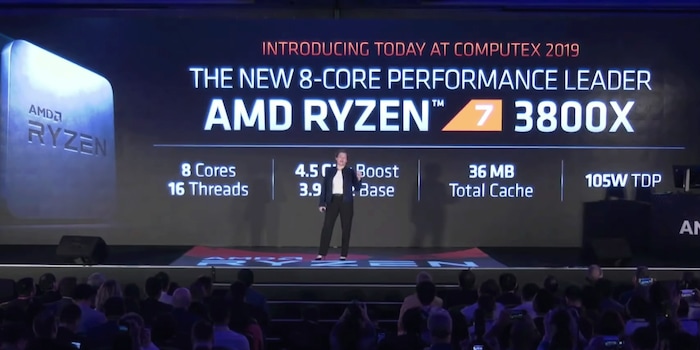
Computex: AMD Ryzen 3000 with up to 12 cores
The Ryzen 3000 generation top model comes with 12 cores and 4.6 GHz… and it’s set to launch on 7 July 2019.
AMD presented the Ryzen 3000 during a keynote at Computex. AMD’s CEO, Lisa Su, confirmed many of the rumours that had been going around in the run-up to the event. But contrary to what had been leaked, the top model only features 12 cores rather than the rumoured 16.
Meanwhile the TSMC processors that are made with 7 nm FinFET process technology boast PCIe 4.0 x16. They’re based on the Zen 2 structure. AMD continues to use an AM4 socket. And none of the models that have been announced so far feature an integrated graphics solution.
But the area that has seen a lot of advancement is the chip. AMD has radically changed its chip structure so the processors are now made up of one central management chip and up to two smaller chiplets, which are the actual processor cores. However, the two chiplets are reserved for the Ryzen 9.
The processors in detail
The Ryzen 9 represents a whole new model in the processor family. The Ryzen 9 3900X boasts 12 cores, a base clock of 3.8 GHz and a 4.6 GHz boost. It also features 70 MB of total cache and TDP (thermal design power) is pretty efficient at 105 W.
Meanwhile, the Ryzen 7 series consists of two models: the Ryzen 7 3700X and the Ryzen 3800X. Both have 8 cores and 16 threads. The 3700X clock speeds are 3.6 GHz for the base clock and up to 4.4 GHz for the boost. Meanwhile, the 3800X reaches 3.9 GHz on the base clock and up to 4.6 GHz for the boost. The total cache on both models is 36 MB, making it twice that of its predecessors. Lastly, the TDP is 65 W on the small 3700X and 105 W on the large version.
Then comes the Ryzen 5 series, which completes the keynote line-up. The Ryzen 5 3600X clocks a bit faster than the Ryzen 3600X: 3.6 GHz at base clock and up to 4.2 GHz for the boost compared with 3.8 GHz base clock and 4.4 GHz boost. Even the Ryzen 5 comes with a decent 36 MB total cache. As for TDP, the Ryzen 3600X records 95 W while the Ryzen 3600 achieves 65 W.
What about performance?
According to AMD, floating point performance has doubled compared with the previous generation and the IPC (instructions per cycle) have increased by 15%, which should benefit all kinds of uses.
AMD put the Ryzen 7 3700X head to head with the Intel Core i7-9700K in Cinebench R20. The results showed the 3700X performed 28% better than the i7-9700K in multi thread performance. Even in single thread performance, the 3700X beat the i7-9700K – although only by a percent. But still. Until now, AMD always lagged behind Intel on single thread performance. The whole time, 3700X was running at 65 W TDP. Meanwhile, the i7-9700K was only at 95 W TDP.
AMD carried out gaming benchmarks on the Ryzen 7 3800X at 1080p resolution. According to the manufacturer, the results show leaps in performance between 14% and 34% compared with the Ryzen 7 2700X.
AMD even demonstrated the performance of PCIe Gen 4.0. Based on the PCMark Benchmark, the new standard delivers up to 69% more performance than the PCIe Gen 3.
Lastly, AMD presented results of the Ryzen 9 3900X compared with the Intel Core i9-9920X. The AMD processor was 18% faster. Furthermore, AMD’s TDP was 105 W, while Intel boasted 165 W.
But as always, these figures have to be interpreted with caution. We’ll only know what kind of performance to expect from the processors once benchmarks are carried out after the launch.
When will they be released aka when can I buy them?
The release is set for 7 July 2019, a date that is symbolic of the new 7 nm manufacturing process. We’ll let you know how much the processors will cost and if we’ll actually get them in stock on 7 July as soon as we have more info.
From big data to big brother, Cyborgs to Sci-Fi. All aspects of technology and society fascinate me.
From the latest iPhone to the return of 80s fashion. The editorial team will help you make sense of it all.
Show all